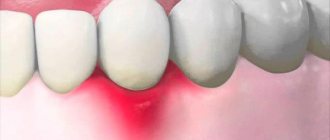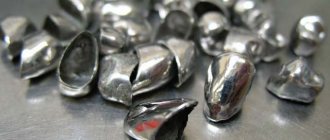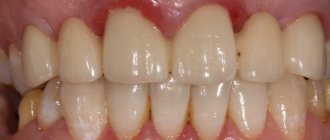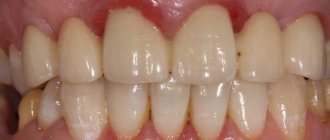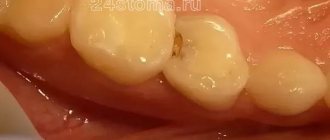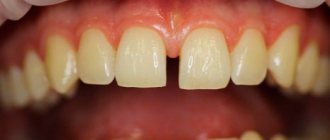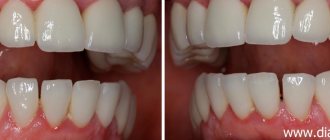Problem: For about five years, a man suffered from food getting between his teeth. Food getting stuck meant that I constantly had to pick between my teeth to remove food debris and my gums became inflamed. Friends advised me to contact Dial-Dent to eliminate the gap between my teeth.
Solution: old crowns on the teeth were replaced (the crowns were more than 5 years old, they were done in another clinic). Using computer modeling, tight contacts between teeth were created and the anatomical shape of the chewing surface was restored. Now food does not get between the teeth, it is chewed better, and the gums do not hurt. With new ceramic crowns from Dial-Dent, the problem is completely solved.
Choosing treatment tactics for food stuck between teeth
At the consultation, orthopedic dentist S.V. Zukor discovered that between the chewing teeth on the lower jaw there is a gap where food gets clogged. Due to food getting stuck between the teeth, the gums are constantly pressed, and the use of various improvised means for picking between the teeth injures the gums even more, so the gums hurt. The teeth have crowns that do not have the correct shape, there is no close contact between the teeth, and the chewing surfaces are almost flat.
To eliminate food getting between the teeth, the dentist suggested replacing the old crowns and making new ones with tight contact so that there is no gap between the teeth.
Food gets stuck between teeth - what to do?
Food getting stuck between teeth is one of the symptoms that you should pay attention to, because this may be a signal of the presence of pathology.
What could be the reason?
Firstly , the carious process on the contact surfaces of the teeth. Over time, when the defect in hard tissues increases, a cavity forms on the contact wall, or a piece of enamel may break off, so food can get stuck in this area.
Secondly , poorly manufactured orthopedic structures, when there is a loose fit or an overhanging edge of the crowns, as well as overhanging edges of fillings, a non-physiologically restored contact point or its absence.
Thirdly , problems of a periodontal nature, when there are so-called pathological pockets where bone loss occurs, which also leads to food getting stuck and accumulated.
Fourthly , wisdom teeth. Very often they do not have enough space and are not located in the dental arch, at an angle. This makes it difficult to carry out thorough hygiene and leads to the formation of a pocket where food debris constantly accumulates.
Let's look at a few clinical cases.
Clinical case 1.
Ekaterina went to the clinic for comprehensive treatment.
At the time of contact there were complaints:
- for partial loss of teeth and the inability to chew food well
- for food getting stuck between teeth
- for bleeding gums
- for bad breath
We conducted an examination and x-ray examination.
There are several areas on the upper jaw where food debris constantly accumulates.
Let's take a closer look at each tooth.
On the CT scan, on the distal surface of the 17th tooth (which is in contact with the wisdom tooth), we see a deep hidden carious cavity, which is almost invisible upon visual inspection. Food gets stuck in this area, which is also facilitated by the presence of a pocket between the 17th and 18th teeth.
The coronal part of tooth 26 is almost completely destroyed as a result of the carious process. There is a cavity and overhanging edges, which is also an area for food accumulation.
On tooth 24 there is an old filling with a defect in the marginal fit and signs of secondary caries.
On a computed tomogram we see a deep subgingival carious defect.
After the consultation, we drew up a treatment plan, but the patient did not start treatment immediately, and after 6 months she went to the clinic with a complaint about a filling falling out of the 24th tooth. This is what it looked like visually:
The carious process had already affected the nerve, there was also significant destruction under the gum, but we managed to save the tooth. We removed all the caries, restored the wall, and treated the root canals. To preserve this tooth, it must be covered with a crown in the near future, since in this case the filling cannot guarantee a hermetically sealed restoration for a long time, there is a risk of re-infection of the root canals and chipping of the tooth.
This could have been avoided with timely replacement of this filling and good interdental hygiene!
Clinical case 2.
Dmitry went to the clinic for a routine examination.
Complaints:
- for missing tooth 17
- for food getting stuck between teeth
- for plaque
- for bleeding gums
- for bad breath
Initial situation.
Objectively: a significant amount of soft and pigmented plaque, supragingival and subgingival tartar.
Hygiene is unsatisfactory. The patient does not use interdental hygiene products.
On the X-ray:
We see signs of chronic periodontitis (generalized loss of bone tissue), which leads to the formation of pathological pockets.
But let’s pay special attention to 2 zones: the 15th tooth and the interdental space of 46-47 teeth.
Between the 46th and 47th teeth there is a deep periodontal pocket, the loss of bone tissue is more significant in this place, which indicates constant food entrapment and the presence of a chronic inflammatory process.
In the oral cavity:
After we removed part of the old filling, we discovered caries on the contact surfaces in the gum area.
On the 15th tooth there is a filling of considerable size with an overhanging edge.
Visually, everything in the oral cavity does not look so scary.
But we take a targeted intraoral photograph, which will allow us to assess the true condition of the periodontal tissues in the area of interdental contacts.
A filling with a huge overhanging edge, which not only contributes to the accumulation of food, but is also a chronic traumatic factor for the gums.
This patient underwent professional oral hygiene in 2 visits, interdental hygiene products (dental floss, brushes, irrigator) were selected and training in the correct technique for their use. After all, home hygiene plays a significant role in the success of our treatment, especially in patients with periodontal tissue diseases.
We then replaced all the old defective fillings and cured tooth decay.
The patient was referred for consultation to a periodontist and orthopedist.
Clinical case 3
Elena came to the clinic for professional oral hygiene.
At the time of treatment, there were complaints about the presence of plaque and constant food getting stuck between the 25th and 26th teeth, rupture of the thread and periodic bleeding.
Objectively: on tooth 26 there is a filling with a defect in the marginal fit, a copious amount of plaque between teeth 25-26. When you try to clean the interdental space with floss, bleeding and an unpleasant odor appear.
On the targeted radiograph: a filling with a defect in the marginal fit and signs of secondary caries on the 26th tooth. Carious cavity on the distal and mesial surfaces of the 25th tooth.
In this case, caries treatment was carried out on the 25th tooth.
The patient was referred to have the 26th tooth restored with a crown by an orthopedic dentist, since the tooth had been treated endodontically and had a significant area of destruction.
Clinical case 4
Evgenia went to the clinic for planned sanitation.
I was concerned about the reaction of some teeth to sweets, food getting stuck in some places, especially in the contact area of 37 and 38 teeth.
Objectively: tooth 38 is dystopic (there is a violation of position - the tooth is tilted towards tooth 37), there is a carious cavity of a significant size on it.
Tooth 37 has a defective filling and a deep carious cavity on the distal surface (in contact with tooth 38), which was formed as a result of prolonged food stuck and the inability to thoroughly clean this area.
In this case, tooth 38 needs to be removed, tooth 37 needs treatment.
Clinical case 5
Victoria went to the clinic to sanitize her oral cavity.
I haven’t been to the dentist for a long time, at the time of contacting I was worried about the following complaints:
- for food getting stuck
- to change the color of fillings
- for increased tooth sensitivity
- reaction of some teeth to sweets
On examination: a significant number of defective fillings with signs of secondary caries.
There are also metal-ceramic crowns in the oral cavity, which were installed about 5 years ago. I would like to draw attention to them to show why low-quality orthopedic structures can cause problems.
In the panoramic image we see that the marginal fit of the crowns is not ideal; food gets clogged in these areas.
But I especially want to pay attention to teeth 45 and 46.
On tooth 45 we see a “gap” between the edge of the crown and the root. On the 46th tooth there is an overhanging edge of the crown and there is a possibility of a carious process at the root. In this case, we may suspect root caries, but the orthopedic surgeon will be able to say for sure after removing the old crowns.
What to do?
If you regularly get food debris between your teeth, you need to make an appointment with your dentist to understand and eliminate the cause. If the problem is left unsolved, it can lead to serious complications:
- Caries
- Root caries, which can lead to tooth loss
- Chronic inflammation of the gums - gingivitis, or the development of localized periodontitis, as a result of traumatization by sharp, overhanging edges of fillings or crowns.
All this is accompanied by such unpleasant symptoms as:
- bleeding gums
- painful sensations
- constant discomfort, bursting sensations
- bad breath
At the appointment, the dentist will conduct an examination and the necessary additional diagnostic measures, which will help find the cause and carry out appropriate treatment:
- cause of caries ➝ treatment of caries and functional restoration of the tooth
- defective seals ➝ replacement of seals
- defective orthopedic structures ➝ consultation with an orthopedic dentist, removal of old dentures and replacement with new ones
- the presence of wisdom teeth that make it difficult to carry out hygiene measures ➝ referral to a dental surgeon for removal
- old fillings of significant size on teeth in which root canals were treated ➝ restoration with crowns, because it is the crown that provides good sealing and will help preserve the function of the tooth for many years, prevent the risk of chips and fractures, which often leads to tooth loss
- if there are periodontal pockets ➝ consultation with a periodontist, professional hygiene, selection of products and training in home hygiene is required, you may need medication or Vector therapy.
To summarize, if food is constantly stuck between your teeth, you should immediately contact your dentist. After all, solving a problem at the initial stage is much easier and cheaper than waiting for complications to develop.
Dental scanning and dental crown modeling
Before modeling the new crowns, a teeth scan was performed. Dental scanning replaces traditional dental impressions, which many patients cannot tolerate due to an increased gag reflex. When taking digital impressions of teeth, the dentist runs a Sirona scanner along the surfaces of the teeth for several minutes, and a three-dimensional image of both jaws is transferred to the computer - a digital impression of the teeth.
Working with a digital impression in a specialized program, the dentist models crowns with the most tight contacts between the teeth and the correct anatomical chewing surface.
Based on the simulation results, the dental technician produced ceramic crowns from E.max ceramics. Pressed ceramics E.max has high strength and excellent aesthetic properties, therefore it is used for prosthetics of both lateral and anterior teeth.
Pain after treatment
Often discomfort between teeth occurs after treatment. This may indicate poor-quality filling and the development of infection inside the canal. In this case, you need to take an x-ray, with which you can immediately detect the pathology.
Important! Trauma to the gums can occur due to an “overhanging” filling that comes into contact with the gingival papilla.
You can detect a filling defect by using dental floss that gets stuck or breaks. Treatment requires correction of the filling or its replacement. Microtrauma from a filling or crown can cause discomfort in the first days after dental treatment. The pain goes away on its own after a few days.
Video - Gums hurt: what to do?
The result of replacing crowns is that food does not get stuck between the teeth
Tight contacts between teeth ensure that food does not get stuck and gums remain healthy.
The cost of ceramic crowns is 55,000 rubles per unit.
Of course, it is possible to make dental crowns cheaper (cheaper material, lack of computer modeling, etc.), but this will invariably affect the quality. The use of computer technology makes it possible to more carefully work out the shape of the crowns, provides additional convenience when taking impressions - all this is reflected in the price, so good dental crowns cannot be cheap. In addition, Dial-Dent uses the highest quality and most modern materials both for the crowns themselves and for their fixation, which increases the service life of dental restorations.
Video about how teeth are scanned with an intraoral scanner:
Possible complications
If not treated properly, the patient may face more serious problems. Their cause is the further development of the disease that provoked pain when pressing on the tooth.
In medical practice, this is called complications - they will vary depending on the original problem.
The spread of infection to surrounding tissues threatens:
- Inflammation of soft tissues, swelling, formation of an abscess.
- Loss of a tooth.
- Spread of the inflammatory process and infection to adjacent teeth.
- Penetration of pathogenic bacteria into the periosteum. Then the entire jaw may suffer.
- The formation of cysts and granulomas, which can provoke the appearance of a fistulous tract with the release of pus through the soft tissues of the oral cavity or even from the outside - on the face and neck.
- The occurrence of an abscess, in which a section of bone in the area of the root apex can be destroyed.
- The development of phlegmon is the entry of infection into the general bloodstream and its spread throughout the body. This is the most dangerous complication of an untreated tooth , which can greatly affect the patient’s health and require emergency measures and long-term difficult treatment.
How to maintain healthy teeth and gums for a long time and extend the life of dental crowns
The dentist said that to maintain healthy teeth and gums, it is necessary to undergo professional teeth cleaning at least once every six months. Dial-Dent understands the importance of prevention and oral hygiene, so they have developed the “Teeth for Life” program. Professional oral hygiene helps remove plaque not only from your teeth, but also from crowns, veneers, implants, thereby extending their service life, and prevents the occurrence of caries, periodontitis and other diseases.
See other examples of the work of Family Dental specialists here.
Make an appointment for a consultation by phone +7-499-110-18-04 or through the form on the website. You can ask questions about dental prosthetics to the chief doctor of the clinic, Sergei Vladimirovich Tsukor, at
Treatment
Treatment for pain in the gums depends on the causes of the discomfort. If the pain is caused by pieces of food stuck in the interdental space, careful oral hygiene and flossing are sufficient. If fillings are installed poorly, they are replaced. Gum inflammation requires the use of anti-inflammatory ointments, gels and rinses.
Important! Painkillers should only be taken as prescribed by a specialist, as they negatively affect the gastrointestinal tract and are not able to eliminate the main cause of discomfort.
Treatment should be carried out by a doctor, but if there is no possibility of contacting a specialist, you can use one of the proposed anti-inflammatory drugs:
| Name | Image | Description | Price |
| Ointment "Parodontocide" | It has analgesic, regenerating and anti-inflammatory properties. Apply after brushing your teeth with a cotton swab or finger. | 125 RUR | |
| Rinse aid "Asepta" | Use after meals. Contains chlorhexidine and benzydamine, which relieve pain and swelling | 170 RUR | |
| Gel "Metrogil Denta" | A drug based on chlorhexidine and metronidazole. Helps relieve pain, inflammation and swelling, reduces bleeding gums. Use 3 times a day | 270 RUR | |
| Gel "Troxevasin" | Gel for relieving inflammation, which strengthens the walls of blood vessels and makes them more elastic. Apply to the damaged area morning and evening | 230 RUR |
- How to close a gap between your front teeth
Removing food jams.
There are many courses for dentists that teach how to create the perfect contact point and eliminate food jams. But despite this, many dentists do not know how to create a good point of contact. The secret of good contact to prevent food getting stuck lies in the doctor’s ability to move the teeth apart from each other while the correct anatomical shape of the tooth is restored, and then allow the teeth to come together with a force that prevents food from penetrating into the interdental space. To create the ideal contact shape, a matrix is used, which, like formwork during construction, creates the correct contour of the tooth.
Israeli dentistry in Crimea has the technology and experience of creating the correct contact point between teeth, solving the problem of food getting stuck. If you need help with this situation, you are welcome to contact us.
Sign up: +7
How to solve the problem without a doctor?
The first thing that comes to mind for a person experiencing discomfort from food stuck between their teeth is the use of toothpicks. Dentists strongly recommend excluding their use in everyday practice. Such “helpers” can seriously injure the gums and accelerate the loosening produced by stuck food.
Attention! The best way to remove food debris in such cases is dental floss. If you happen to see a wide thread with wax on sale, it is better to purchase it. She will help out well at a party.
At home, an irrigator will help more effectively. It perfectly washes away food debris in the mouth. When a person already has periodontal pockets, the irrigator will become a lifelong assistant. It is rightly said that you do not need to care only for those teeth that the surgeon has removed. Floss and regular brushing are effective in making you feel better. But they don't solve the problem completely. Repeated food getting stuck between the teeth tells the patient that he needs to see a dentist who not only does fillings, but also knows how to work with dentures.
Dental floss, also known as floss, is an additional oral hygiene product that is used to clean interdental spaces and prevent the occurrence of caries and periodontitis.
Consequences of food stuck between teeth
The result of constant jamming is that the teeth lose their hardness.
Important! Food remains between the teeth for a long time, while their enamel is damaged and periodontal pockets are formed. They provide direct access to various infections, which leads to gum abscess.
And there is a negative progression in this problem. The food penetrates further into the pocket, deepening it, and the bone is affected. Tooth decay occurs when food gets stuck between adjacent teeth. It doesn't show up right away. And treatment is complicated by poor access to the lesion site. The damage caused by stuck food is irreversible. Not only the tooth suffers, but also the tissues supporting it. If left untreated, its destruction and removal cannot be avoided. When stuck food sits in your mouth for a long time, it can ferment and cause an unpleasant odor.
A periodontal pocket is a space formed due to the destruction of the dentogingival junction and circular ligament of the tooth, as well as resorption of bone tissue and alveolar walls.
Caries between teeth: symptoms and diagnosis
Diagnosing caries between teeth sometimes causes certain difficulties due to the fact that visual control is difficult. Methods for diagnosing interdental caries at a dental appointment:
- Visual inspection − Using a special dental mirror and probe, you can usually look into even the most difficult to reach areas. However, this method is not always effective, because when the carious defect is very small or there is crowding of teeth and very tight interdental contacts, in these cases additional diagnostic methods are sometimes needed.
Caries between the front teeth (Fig. 3): the letter (a) in the figure indicates carious defects between the central incisors (they look like darkening under the preserved surface layer of enamel), and the letter (b) indicates fillings on the contact surfaces in the adjacent interdental space, where interdental caries was cured some time ago. - X-ray diagnostics - On an x-ray, enamel and dentin are light in color, and a carious defect, in turn, will look like a dark spot on a lighter background. On the radiographs (Fig. 4-5), arrows indicate darkening, which is interdental caries.
- Using the Diagnodent device − The operation of the device is as follows: the device emits light waves and immediately picks up the reflected light. If there are carious defects (tooth areas with low mineralization), the device will sound an alarm.
How to independently determine the presence of interdental caries -
- Firstly , in good lighting it can be seen that the transparency and color in the lateral parts of the tooth crown have changed, and something dark can be seen through the intact enamel - as in Fig. 3.
- Secondly , caries can be accompanied by minor pain from chemical (sour, sweet foods) and thermal irritants (cold/hot water). Moreover, pain during caries usually quickly passes after the effect of the irritant stops. Even if you do not see the destruction of the tooth crown, but such pain periodically occurs in a certain tooth, it is best to consult a dentist to confirm or exclude the occurrence of caries between the teeth.
- Thirdly , an unpleasant odor and taste spreading from a specific interdental space. If a carious defect has formed in the interdental space, then the latter is an excellent place for the accumulation of food debris and cariogenic microorganisms. Microbes digest food (which corresponds to the processes of decay of food residues) and this is accompanied by an unpleasant odor.
